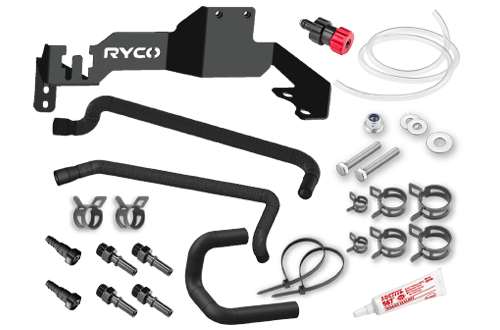
Now you have your hands on one of the last V8 diesel Toyota LandCruiser 200 Series 4x4s it’s time to protect your investment with a secondary fuel water separator and crankcase ventilation catch-can using the Ryco Filters RVSK105 and RCC351.
Four-wheel drives like the Toyota LandCruiser are an Aussie favourite. Comfortably and capably transporting the family to some of the most rugged parts of the country, the LandCruiser line-up has taken pride of place in the four-wheel drive scene since the late 1950s.
The latest LandCruiser 200 Series is now a highly sought-after four-wheel drive; and with news the V8 diesel has been replaced in the future line up, new-car stock is drying up fast. Recreational off-roaders, agricultural and rural buyers have all put their orders in, as has anyone needing to tow up to 3500kg comfortably while still accommodating the up to five adult passengers. Yes, the last of the LandCruiser 200 Series are selling fast.
But as production of the LandCruiser 200 Series draws to an end, the need to protect its gutsy 4.5-litre V8 twin-turbo diesel engine from potential damage is more relevant than ever. Like any common-rail diesel engine, fuel contamination can be an owner’s worst nightmare, leaving a trail of destruction from the lift pump to the injectors, and ending with a nasty repair bill.
Over the long-term the other culprit is the build-up of carbon caused by the combination of important emission control systems, and start-stop suburban driving conditions. This is a problem we could kick down the road, but when that check engine light eventually comes on, the remedy is not a five-minute fix.
Today, you could argue the LandCruiser 200 Series is an investment. Prices on the second-hand market are comparable to new, and there are two very simple upgrades to the mighty 1VD-FTV 4.5-litre twin-turbo diesel any new owner should consider.
Firstly, a secondary fuel/water separator installed inline, but before Toyota’s factory fuel filter; and secondly, a catch-can, installed within the crankcase ventilation system, catching and separating oil-based crankcase gases preventing them from mixing with hot exhaust gases within the intake manifold.
Now, where do you fit these two devices when engine bay real-estate is at a premium? With twin-turbos feeding a top-mounted intercooler options are limited for adjusting fuel lines and re-routing emission hoses. This is where 3D modelling allows Ryco engineers to find space that will perfectly place the fuel/water separator and catch-can as if Toyota planned it from the factory, using the RVSK105 fitting kit.
In common-rail injected turbo-diesel engines like Toyota’s 1VD-FTV, water can destroy fuel pumps and injectors. The common causes of fuel contamination from water are from poor fuel at the source (i.e. the service station), a leaking jerry can, damaged seals on the filler neck or fuel cap, and even rubber-to-steel joins in the fuel line itself. They’re issues that are difficult to mitigate, but ones that can be addressed by the installation of a Ryco Z980S fuel/water separator.
The filter is suitable for diesel and biodiesel (up to B20) fuel types where the rate of the lift pump does not exceed 120 litres per hour. It fits in-line on the RVSK105 bracket and traps any contaminants denser than fuel which then fall to the bottom of the trap, while lighter fuel flows into the second stage filter.
Here, the treated filtration media separates water from fuel on its repellent surface – in this case a combination of silicone-treated cellulose and glass-microfibre hydrophilic depth coalescing media. Water particles form large droplets which fall to the trap below preventing water from entering the factory fuel filter, fuel pump and injection system.
We all understand the important role vehicle emissions controls play in protecting the environment. Unfortunately, the combination of exhaust and crankcase gases within the intake system, can result in the build-up of carbonised oil vapour restricting the air intake manifold to a point where engine performance is reduced, and misfires may occur.
In the case of the Toyota LandCruiser 200 Series – and most other petrol and diesel engines – the vaporous gas created in the crankcase is released back into the air intake manifold via a closed system known as the Positive Crankcase Ventilation (or PCV) system. In perfect conditions the PCV system can control all crankcase vapours produced, but as we all know, not all four-wheel drives operate in perfect conditions.
Factors including start-stop driving, low-temperature operation and inconsistent crankshaft speeds create excessive blow by (a condition whereby expanding gasses are forced past the piston rings and into the crankcase), especially in higher output turbocharged engines like the 1VD-FTV unit found in the LandCruiser 200 Series.
The other issue facing modern air intake manifolds is recirculated gasses collected from the EGR. These gasses occupy the space that would otherwise be taken up by oxygen, lowering combustion temperatures and reducing the output of NOX gases. However, the hot EGR gasses tend to react with any oil vapour found in the crankcase gases depositing in the air intake manifold by the PCV system, carbonising to form a ‘baked-on’ substance that, left unchecked, can restrict the passage of air within the intake manifold.
The RCC351 crankcase ventilation catch-can prevents the collection of sludge in the intake manifold by ‘catching’ and filtering vaporous gases before they reach the air intake manifold. The unit separates vaporised oil from the PCV system, allowing only hydrocarbon gas to enter the air intake manifold. Oil is retained in a sump at the base of the unit for safe disposal during scheduled servicing.
Now, because the gas entering the air intake manifold does not contains the chemicals that cause sludge formation, carbonisation of the air intake manifold is effectively reduced.
Available from all leading stockists, ask for the RVSK105 fitting kit, RCC351 Catch Can and Z980S fuel water separator to protect your 200 Series.
This article is brought to you by Ryco